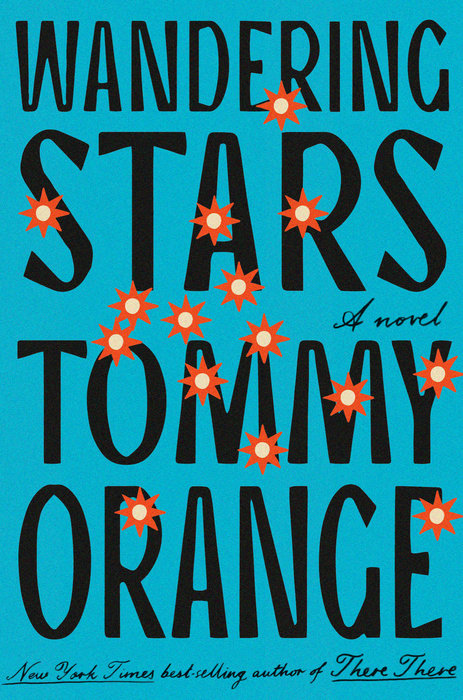
Your heart, that place
you don’t even think of cleaning out.
That closet stuffed with savage mementos.
-Louise Erdrich, Advice to Myself
Tommy Orange’s Wandering Stars is an ambitious family saga that is both a prequel and sequel to his brilliant debut novel, There There. It follows a family for over 150 years, from Jude Star escaping the Sand Creek Massacre in 1864 to the Bear Shield/Red Feather family in present day Oakland. In the family’s struggles against institutionalized violence, genocide was only the beginning. Each generation inherits the trauma of their ancestors while facing fresh injustices. The government-sponsored erasure of Native American identity, cultures, languages and beliefs doesn’t completely strip them of their heritage, but what survives is fragmented and incomplete. Star and his descendants try to rebuild their shattered identity, either by reconstructing the pieces or by replacing them with other things: sometimes art, sometimes addiction, often both.
The book is divided into three sections covering seven generations of the family. Part One spans 150 years, starting with the Sand Creek Massacre. Parts Two and Three start in 2018, following the Bear Shield/Red Feather family. Given the vast difference in time periods these sections cover, it’s no surprise that the pacing and style change drastically from one to the next. Part One is episodic and reads like a combination of diary entries and historical commentary. Parts Two and Three are more comfortably literary, exploring the thoughts and motivations of the characters much more deeply. Part One can cover several decades in a chapter. Chapters in Part Two or Three rarely exceed more than a year, often lingering on a single day.
Had Part One been written like the rest of the novel, it would have tripled the size of the book. But that wouldn’t be hard to defend. It tells important stories, showing people surviving governmentally-condoned murder and erasure of their culture. As is, this section may lose readers because, on an individual level, the personal narratives feel rushed and characters disappear or die before there’s time to know them well enough to mourn them. Still, perhaps that’s intentional. This style and pacing could be a kind of nod to ancient texts, with fragmented characters like the papyrus fragments containing parts of Sappho’s poems. It would certainly fit the theme.
That said, the opening line to the novel and Jude Star’s story is magnificent: “I thought I heard birds that morning time just before the morning light, after I shot up scared of men so white they were blue.” The peaceful song of the birds is shot down by the appearance of the white/blue men. This use of color not only invokes the blue uniforms of the Union soldiers raiding Cheyenne camps, it also merges their skin and with their clothes. The soldiers become otherworldly and eldritch, a horde of Lovecraftian monsters mindlessly consuming an entire community.
Is this interpretation a stretch? Writers often write what they know and it’s no historical accident that Native American horror is currently blossoming. During a talk at the Festival America in Vincennes – France, the Cree writer Billy Ray Belcourt said that white North Americans rarely understand that Native Americans are navigating a post-apocalyptic world. The opening chapter of Wandering Stars, depicting Jude Star’s survival of the Sand Creek Massacre and the subsequent months, illustrates Belcourt’s statement wonderfully.
Sometimes it felt like the world had ended and we were waiting for the next one to come. More often it felt like I was waiting for the sounds of war to come back again, for the first light of the sun to bring with it blue men come to kill and scatter us again, thin us out across the land like the buffalo, chase and starve and round us up like I’d heard by then they were doing to Indian people everywhere.
We saw and ate many strange things going around together looking for our people.
After the apocalypse, survival comes first. This could explain why many characters’ stories in Part One rush with such speed to their end. This is the world of brief lives and struggle that Jude Star and his descendants live in. Much modern literary fiction focuses on interiority and identity. But rarely are characters stripped of so many of the institutions that compose identity: family, economy, culture, religion and language. For Jude Star, the Sand Creek Massacre shattered all those things. The style and pacing of Part One reflect the advances and reversals that his descendants experience as they fight to reconstruct their heritage and themselves.
Once we reach the Bear Shield/Red Feather family, the pacing slows, giving an impression of a wider psychological breadth for the characters. But the impact of their ancestors’ lives is ever-present, and with it the fear that their stories will be cut short by addiction and violence. We first see Orvil Red Feather looking up “what other kids on the internet had to say about surviving a shooting.” Recovering from a gunshot himself, he’s prone to nightmares and starts taking more painkillers than necessary. He’s just in high school, but this ancestral cycle of tragedy already seems to have drawn him in.
Everyone in Orvil’s family is navigating through their trauma. Opal, the Red Feather boys’ guardian, tries to keep them safe while managing serious health issues. Jacquie, Orvil’s grandmother, is a recovering alcoholic. But particularly terrifying is Orvil’s youngest brother Lony, a sweet little boy who’s cutting himself and inventing blood ceremonies to reconnect with his heritage after he reads on the internet that “the name Cheyenne meant the cut people.” Lony approaches self-mutilation with the matter-of-factness of a young boy, a bartering logic that would appeal to an impressionable child: If he gives a piece of himself, the universe will make his family whole and save them from more pain.
Dark stuff, but the novel has spurts of a wry humor throughout as well. A great example are the dialogues between Orvil’s friend Sean and his father. Sean, who was adopted by white parents, is Black and Native. Sean already thought that “everything about race and background was trickier when you were adopted.” Then his father finds out from a DNA test that he’s 12.5% Native American and talks as if this previously unknown 12.5% now gives him and Sean a shared racial-cultural experience. When he grasps at straws, saying, “There might have been a chief in our line.” it’s both hilarious and tragic. Dreaming up fictional ancestors who were Native American chiefs is a uniquely white obsession. But it’s true; analyzing statements on race is tricky when you’re looking at fantasies of a man who discovers later in life that he’s “part Indian.” Sean’s right that the conversation “feels gross,” but it’s hard not to see a clumsy father, desperate to connect with his son. It’s also funny.
This complexity of emotions and motivations has the characters running in circles. Each of them is saddled with personal battles, family struggles and a culture bent on erasing them. They’re expected to integrate their Native identity into a modern American life without justice for centuries of oppression. But despite reversals and setbacks, they still find humor and love. Healing is possible, but they have to understand the depths of their wounds before they turn mortal.
Publisher: Knopf
Publication date: February 27, 2024
Reviewed by David Lewis
David Lewis’s reviews and fiction have appeared or are forthcoming in The Los Angeles Review of Books, Joyland, Barrelhouse, Strange Horizons, The Weird Fiction Review, Ancillary Review of Books, 21st Century Ghost Stories Volume II, The Fish Anthology, Willesden Herald: New Short Stories 9, The Fairlight Book of Short Stories, Paris Lit Up and others. Originally from Oklahoma, he now lives in France with his husband and dog.
